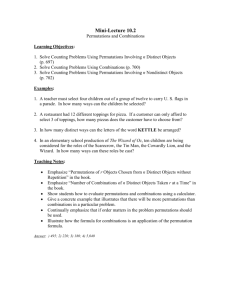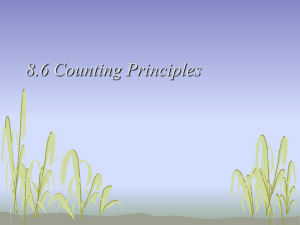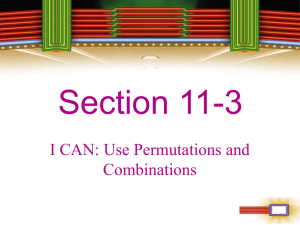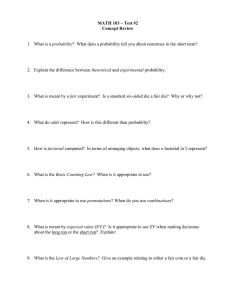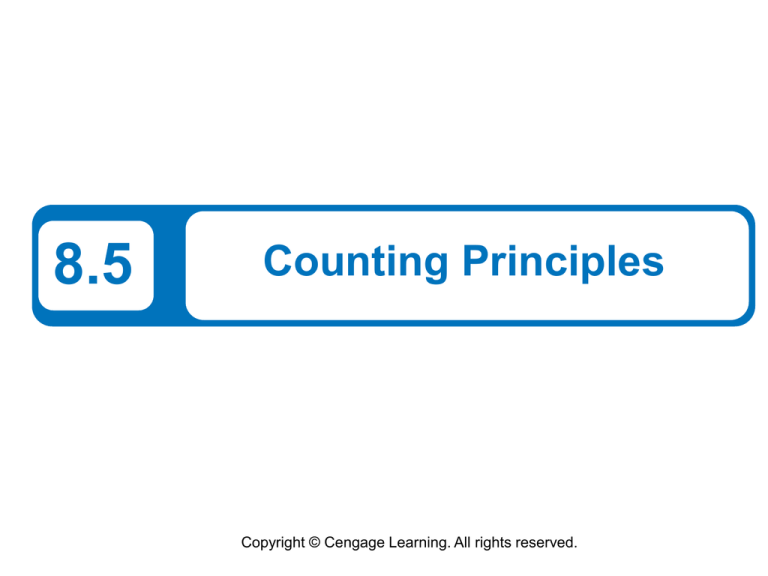
8.5
Counting Principles
Copyright © Cengage Learning. All rights reserved.
What You Should Learn
•
•
Solve simple counting problems
Use the Fundamental Counting Principle to
solve more complicated counting problems
•
Use permutations to solve counting problems
•
Use combinations to solve counting problems
2
Simple Counting Problems
3
Example 1 – Selecting Pairs of Numbers at Random
Eight pieces of paper are numbered from 1 to 8 and placed
in a box. One piece of paper is drawn from the box, its
number is written down, and the piece of paper is returned
to the box. Then, a second piece of paper is drawn from
the box, and its number is written down.
Finally, the two numbers are added together. In how many
different ways can a sum of 12 be obtained?
4
Example 1 – Solution
To solve this problem, count the number of different ways
that a sum of 12 can be obtained using two numbers from
1 to 8.
First number
Second number
From this list, you can see that a sum of 12 can occur in
five different ways.
5
The Fundamental Counting Principle
6
The Fundamental Counting Principle
7
Example 3 – Using the Fundamental Counting Principle
How many different pairs of letters from the English
alphabet are possible?
Solution:
There are two events in this situation. The first event is the
choice of the first letter, and the second event is the choice
of the second letter.
Because the English alphabet contains 26 letters, it follows
that the number of two-letter pairs is
26 26 = 676.
8
Permutations
9
Permutations
One important application of the Fundamental Counting
Principle is in determining the number of ways that n
elements can be arranged (in order).
An ordering of elements is called a permutation of the
elements.
10
Example 5 – Finding the Number of Permutations of n Elements
How many permutations of the following letters are
possible?
A B C D E F
Solution:
Consider the following reasoning.
First position:
Second position:
Third position:
Fourth position:
Fifth position:
Sixth position:
Any of the six letters
Any of the remaining five letters
Any of the remaining four letters
Any of the remaining three letters
Either of the remaining two letters
The one remaining letter
11
Example 5 – Solution
cont’d
So, the numbers of choices for the six positions are as
follows.
The total number of permutations of the six letters is
6! = 6 5 4 3 2 1 = 720.
12
Permutations
13
Permutations
Using this formula, find the number of permutations of eight
horses taken three at a time is
= 336
14
Example 7 – Distinguishable Permutations
In how many distinguishable ways can the letters in
BANANA be written?
Solution:
This word has six letters, of which three are A’s, two are
N’s, and one is a B. So, the number of distinguishable ways
in which the letters can be written is
= 60.
When you have repeats, you must divide by the # of
repeats! (factorial) for each reapeated item.
15
Example 7 – Solution
cont’d
The 60 different distinguishable permutations are as
follows.
AAABNN
AABNAN
AANBAN
ABAANN
ABNANA
ANABAN
ANBAAN
AAANBN
AABNNA
AANBNA
ABANAN
ABNNAA
ANABNA
ANBANA
AAANNB
AANABN
AANNAB
ABANNA
ANAABN
ANANAB
ANBNAA
AABANN
AANANB
AANNBA
ABNAAN
ANAANB
ANANBA
ANNAAB
16
Example 7 – Solution
ANNABA
BAANNA
BNAAAN
NAAABN
NAANAB
NABNAA
NBAAAN
NNAAAB
ANNBAA
BANAAN
BNAANA
NAAANB
NAANBA
NANAAB
NBAANA
NNAABA
BAAANN
BANANA
BNANAA
NAABAN
NABAAN
NANABA
NBANAA
NNABAA
cont’d
BAANAN
BANNAA
BNNAAA
NAABNA
NABANA
NANBAA
NBNAAA
NNBAAA
17
Combinations
18
Combinations
When you count the number of possible permutations of a
set of elements, order is important.
As a final topic in this section, you will look at a method for
selecting subsets of a larger set in which order is not
important.
Such subsets are called combinations of n elements
taken r at a time. For instance, the combinations
{A, B, C} and {B, A, C}
are equivalent because both sets contain the same three
elements, and the order in which the elements are listed is
not important.
19
Combinations
So, you would count only one of the two sets. A common
example of a combination is a card game in which the
player is free to reorder the cards after they have been
dealt.
20
Example 8 – Combinations of n Elements Taken r at a Time
a. In how many different ways can three letters be chosen
from the letters A, B, C, D, and E? (The order of the
three letters is not important.)
b. A standard poker hand consists of five cards dealt from
a deck of 52. How many different poker hands are
possible? (After the cards are dealt, the player may
reorder them, so order is not important.)
21
Example 8 – Solution
a. You can find the number of different ways in which the
letters can be chosen by using the formula for the
number of combinations of five elements taken three at a
time, as follows.
b. You can find the number of different poker hands by
using the formula for the number of combinations of 52
elements taken five at a time, as follows.
22

